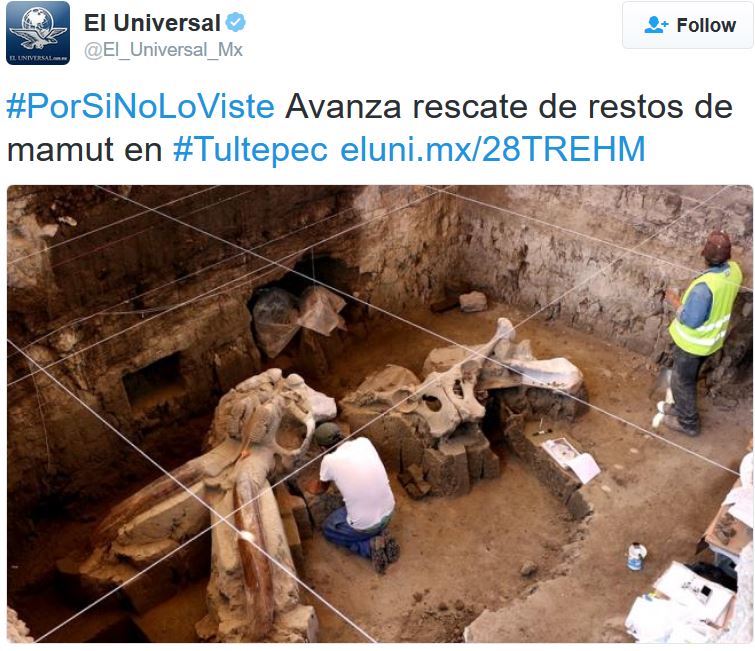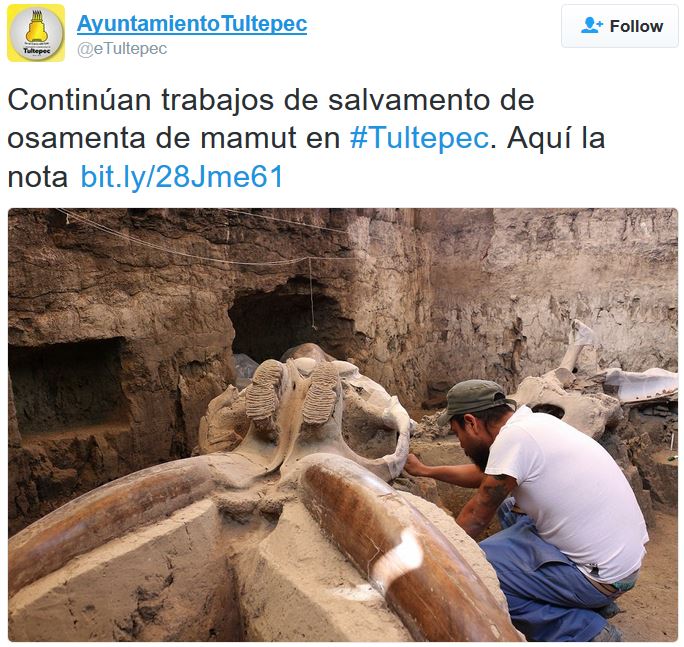Mammoth bones have been discovered near Mexico City, in what archaeologists describe as the country’s find of the decade. The fossilised bones were found while drains were being installed in a street in the town of Tultepec.
Tultepec, which in Náhuatl (language of the Aztecs) means ‘hill of the tule plant’, is a town and municipality in the State of Mexico, directly north of the country’s capital, El Distrito Federal (Mexico City Federal District), making it part of the metropolitan area of Greater Mexico City.
The bones are thought to be approximately 14,000 years old, says Luis Cordoba Barradas, an archaeologist who works at El Instituto Nacional de Antropología e Historia (INAH). The way the bones were scattered suggests that the mammoth had been cut up by humans who lived in the area for its meat and pelt.
 Mexican newspaper El Universal tweets (translated) “Recovery of the remains of a mammoth advances.” (Image: twitter.com/El_Universal_Mx)
Mexican newspaper El Universal tweets (translated) “Recovery of the remains of a mammoth advances.” (Image: twitter.com/El_Universal_Mx)
Mexico City and its surrounding areas are rich in fossilised mammoth bones, according to INAH. So far, over fifty mammoths have been discovered in the area.
This latest find occurred two metres below the ground while workmen were installing drains in a street (called Calle Saucera). Experts estimate the animal died when it was between 20 and 25 years old.
The bones have been surprisingly well preserved – the animal’s tusks are still attached to its skull.
According to INAH, the fossilised bones will be carefully assembled and then put on public display.
The Columbian Mammoth
The bones are of a Columbian Mammoth (Mammuthus columbi), a species that inhabited North America, from what is today Costa Rica in Central America to the northern USA, during the Pleistocene epoch (2,588,000 to 11,700 years ago).
 The Ayuntamiento Tultepec (Town Council – Town Hall) wrote (translated): “Rescue work on the mammoth bones in Tutlepec continues.” (Image: twitter.com/eTultepec)
The Ayuntamiento Tultepec (Town Council – Town Hall) wrote (translated): “Rescue work on the mammoth bones in Tutlepec continues.” (Image: twitter.com/eTultepec)
It was one of the largest mammoth species, weighing from 8 to 10 tonnes (18,000 to 22,000 pounds) and reaching a height of about 4 metres (13 feet) at the shoulders. The African Bush Elephant, the largest elephant alive today, is about 3.3 metres tall at the shoulders and weighs from 4 to 6 tonnes.
The Columbian mammoth evolved from the Steppe mammoth when it came into North America from Asia approximately 1.5 million years ago. The Columbian mammoth is the ancestor of the Pygmy mammoth, which lived on the Channel Islands of California.
Its closest living relative is the Asian elephant.
(Mammuthus columbi) had four large molars and curved tusks, which during its lifetime were replaced six times. Experts believe the tusks were used for fighting, foraging and manipulating objects, in the same way modern elephants use their tusks today.
It fed on grass, sedge (a grass-like plant with triangular stems and inconspicuous flowers) and other plants, and preferred open areas such as parkland landscapes.
The ranges of the Columbian mammoth and Woolly mammoth – which lived in the Arctic regions of Canada – overlapped. There is genetic evidence suggesting that the two species interbred.
 The archaeologists were surprised at how well preserved the bones are. (Image: tultepec.gob.mx)
The archaeologists were surprised at how well preserved the bones are. (Image: tultepec.gob.mx)
Palaeoamericans – the first human beings to inhabit the American continent – and Columbian mammoths coexisted for a few thousand years before the species became extinct. Humans hunted them for food and pelt, and used their bones for making tools.
According to Tultepec Town Council, Dr. Córdova Barradas and fellow archaeologist Felipe Muñoz are carefully unearthing and piecing together the fossilised bones, with the ultimate aim of assembling a whole mammoth skeleton.
Within the next ten days they expect to move the animal’s jaw, pelvis and a number of molars.
Tultepec Town Council says it is currently getting the necessary paperwork ready, and will then ask INAH to house the mammoth bones. Mexican law states that any archaeological find automatically becomes the property of the Patrimonio Nacional (National Heritage – Mexico’s National Trust).
Video – Elephant morphs into Columbian Mammoth
In this 3D video you can watch a modern elephant gradually morph into a Columbian Mammoth.
